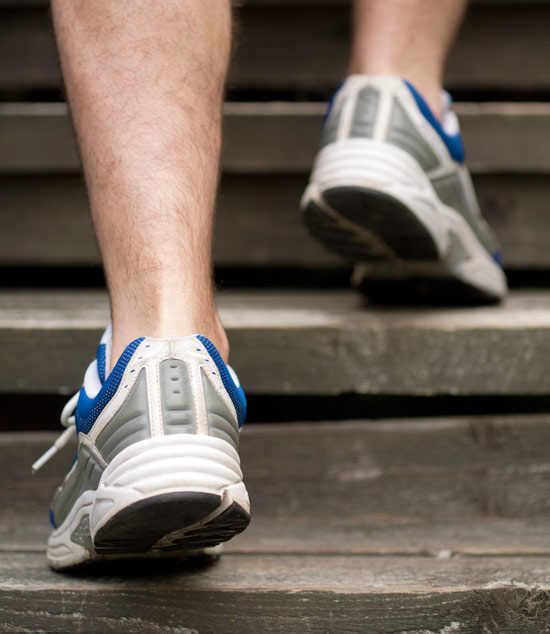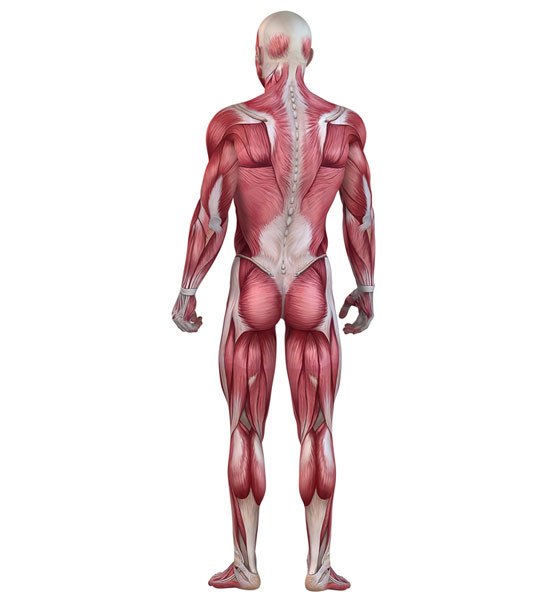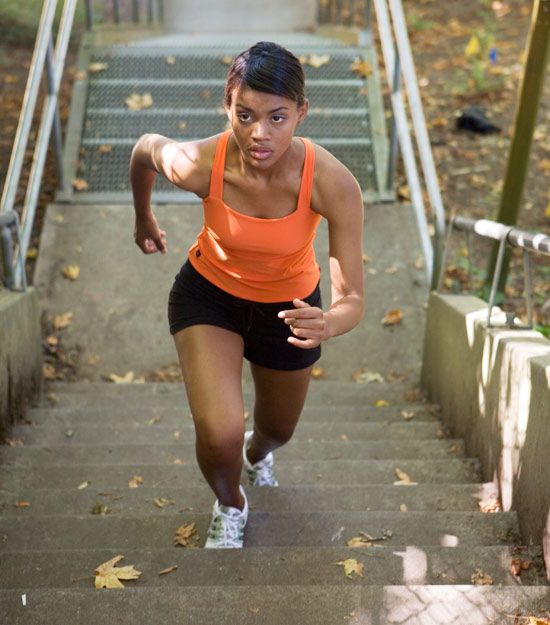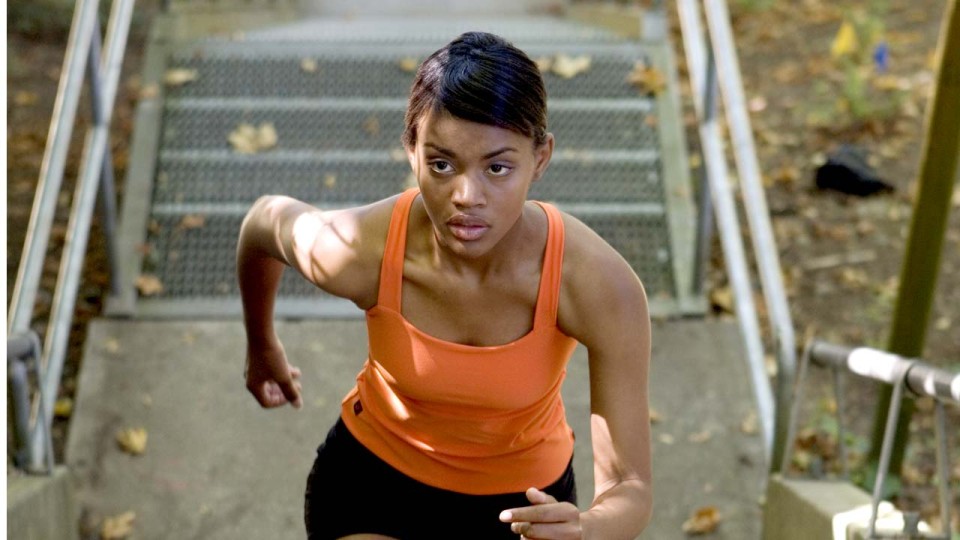Running stairs is an exercise with many benefits. It can be done anywhere, at home, work, the gym. It’s a workout by itself or an excellent addition to fitness training. Strengthen the core, lose weight and develop endurance simultaneously.
Running stairs melts fat. It’s used by track athletes, martial artists, basketball and soccer players. It increases endurance and helps make short distance sprinting easier.
Stair Climbing as Exercise (Proper Stair-Climbing Technique)
Find Your Rhythm
Some say it’s better to run stairs skipping every other step. While it can ensure a decent stride frequency and maximise speed, hitting every step doubles the exercise, helps develop balance and increases muscle development. It’s excellent for the quadriceps, the front of the thighs, as well as the buttocks.
Outside of leg muscles, it’s also an outstanding exercise for the heart as you carry body weight against gravity.
Good Climbing Posture
It shouldn’t be only legs getting the workout. Engage the entire body. Lean forward slightly from the hips and keep the back straight. Never round the lower back area. Arms should be in full motion.
Keep them semi-flexed. Elbows in and shoulders down. Don’t let your chin drop. Your line of vision should be focused on the top of the stairs while keeping an eye on the stairs. Avoid bending the head throughout the exercise.
Push with your thighs and avoid extending your legs. That will put too much strain on the knees. Run with the legs semi-flexed and slightly bent as you hit each step.
Use the Toes
Step on the toes, specifically between the toes and mid-foot. Remind yourself constantly to not land on the heel.

The Role of the Posterior Chain
The posterior chain is a series of tendons, muscles and ligaments located at the back of the body. Many of them are important to running stairs.
When jogging or running, expect the calves, hamstrings and glutes(the buttocks) to handle the majority of the movement.
The glutes, or gluteus maximus, make up the appearance and shape of the buttocks. All these muscles should be in play. Don’t push through the knees alone. Use the posterior and extend the hips.

Mental Preparation
Running stairs is an easy and challenging method for staying in shape. If not done properly though, there’s the possibility of injury, everything from sprains to broken ligaments.
Going Up!
When a bodybuilder pushes weight, they imagine it as a power move. Every step run has to be viewed the same way. Actively put every part of the body into the climb. Drive yourself to the top step and beyond. Produce the force that creates what is called a triple extension of the knees, hips and ankles.
Triple extensions require preparation. Run in place in front of a full length mirror. Are you extending at the ankles, hips and knees?
It could seem like a minute detail, but a professional athlete is aware that properly straightening the ankles by itself has a tremendous impact on not just safety, but power. Done right, the move can increase your workout potential boost by 5% to 15% per session.

You also want to look out for appropriate landing on the feet. For each step, pull the toes toward the shin. Landing on the toes with the heel turned up can cause pain and damage to the shin, hamstring, hip flexor and knees.
In time, it can produce back problems and other core issues. Try to take each step with the toes up, weight on the balls of the foot, pushing through the leg.
Coming Down!
A lot of problems occur when we reverse direction. This is mostly because we’ll pay less attention to form as we experience fatigue. This can lead to less focus, allowing simple momentum to guide us.
We run the risk of losing power that will be needed to get back up effectively and efficiently. Also keep in mind gravity and poor biomechanics can aggravate tightness and will cause muscle soreness.
There are ways to avoid this. On the way down, we tend to let the knees take most of the impact. It should be going to the hips. Decrease the possibility of injury by focusing on letting the glutes absorb the impact and not dropping that foot.
Do keep the knee aligned with the second toe. Also, as stated in the previous paragraph, let the hip work with the feet.
We naturally hike the opposite hip side as we step. Your hips should be behind you, maintaining the posture you used going up. The hand rail can be utilised going down until you’ve gotten comfortable using the hips correctly.
When In Action…
Have a light meal. There’s no need to overdo the carbohydrates, as this isn’t an endurance race. A good protein shake with perhaps a banana is more than enough energy.
Start out slow: walk the stairs. Or jog. The most common mistake new climbers make is going too fast too soon, burning out early. They end up pushing too far and getting physically ill. You need to develop momentum.
Up, down, rest a half to a full minute and do it again. Gradually increase speed and repetitions. Up and down once is the equivalent of a rep. How well you’re doing should be gauged by time. The longer you can do it with the most reps. This should include a cool down, which is essentially walking down at the end.
Drink water during and after the stairs running sessions. If you’re getting red faced, feeling dizzy and nauseous or disoriented, etc., those are signs of hyperventilation.
Proper Stair-Climbing Technique Video
This video shows you how to properly do a stairs running workout for maximal results.
Running stairs is one of the most effective and easy ways to get in shape. This drill is inexpensive, requiring no equipment or membership fees.
Start small, increase difficulty at your pace and marvel at the results. Watch your body strength and mental confidence grow utilising running stairs as a heath tool.
Stairs Climbing For Weight Loss
The health benefits of climbing stairs go beyond burning calories and controlling your BMI.
Stairs climbing also strengthens and tones the calves, quads, glutes, and hamstrings while improving aerobic capacity. Plus, you build strong bones, which help prevent falls and fractures, and reduce your risk of osteoporosis.
One study found that the average energy expenditure for climbing a step was 0.09 calories. Multiply the calories by 1,400, which is the number of steps taken to walk a kilometer at a normal pace, and you’ll burn 126 calories.
You can burn more calories if you increase the intensity of your climb.
Knee Pain During Stair Climbing
Damaged cartilage may not cause pain when walking. But when you run, squat, or climb stairs, you put extra stress on your knees and the pain increases.
These types of movements force the kneecap to slide up and down. When the knee is under stress, the worn down cartilage cannot hold the kneecap in its groove. When the kneecap slips out of position, it causes pain.
Like other activities, stair climbing requires proper posture, especially if you have tender knees. So remember to apply the proper stair-climbing technique that was mentioned in this article.
If climbing stairs causes pain, check your posture and the alignment of your feet and legs.
If your knee pain gets worse or persists for more than two weeks, you should contact an orthopedic doctor. Continuing to walk with knee soreness can cause serious internal damage to the tendons and ligaments in the knee.
Benefits of a Stair Climbing Machine or Stair Climber
Stair climbers are stationary exercise equipment that basically provide a spiral staircase similar to a treadmill.
The machine allows users to climb stairs at the pace and incline they want, providing themselves with an efficient cardio workout.
If you prefer to do stair climbing indoor to burn fat and stay in shape, you can go to the gym or get a stair climber. The benefits of using the stair climber include:
- Stair climber provides a great cardio workout
- Stair climber offers the user something different
- Using the step climber burn more calorie than treadmill
- Stair climber is great to build up and tone your legs
- Stair climber is ideal to train your butt
- Stair climber strengthens the core and tone the muscles
- Stair climber is good for the joints
- Stair climber is better than climbing real stairs
And if you’re able to follow these simple tips and rules consistently you’ll be well on your way to getting to the top of a virtual race soon!
Find Out More About Stairs Running Benefits
Are running stairs a good workout?
Stairs running challenge your body, stamina, strength and endurance. Stair climbing is one of the best workouts to tone your lower body with fast fat burning, tone your butt, thighs and calves, and help build great abs.
Is stair running better than running?
Climbing stairs burns half as much calories as running and high-intensity stair running burns more calories in a shorter amount of time than running or walking.
Does stair running build muscle?
Stairs climbing activates the core muscles in the legs, such as the calves, glutes, hamstrings, and quadriceps. This will make your legs and bones stronger.
Is it good to run stairs everyday?
Study shows that regular stair climbing can lower your resting heart rate and improve your balance. Each step up and down helps shape and tone different muscles in the legs and lower body. Overall, the ability to climb stairs is a good indicator of overall health.
Can you lose weight running stairs?
Yes. The number of calories burned while running stairs depends on the workout intensity and your body weight. Climbing one flight of stairs (usually 10 to 14 steps) burns about 2 to 5 calories. Thirty minutes of running on the stairs can burn up to 500 calories.





